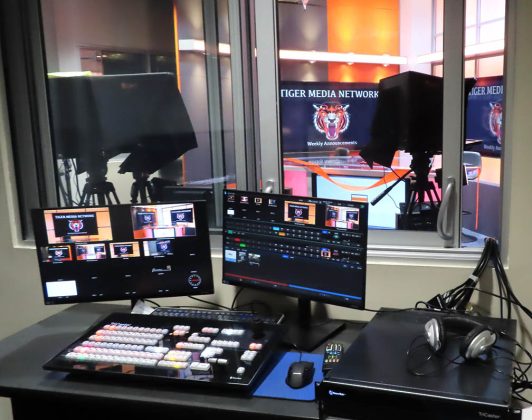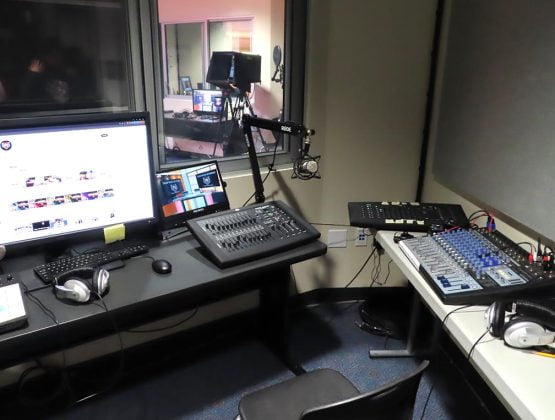
Students at San Jacinto High School are now able to get a feel for top-notch video production with the recent completion of an $800,000 studio on campus. The soundproof recording studio is flanked by audio and visual control rooms where students are learning the ins and outs of creating broadcasts that go out to classmates and others.
Jeremy Murphy, who teaches three introductory courses for Video Production and two capstone courses called Advanced Video Production, has been at the school since the fall of 2020. His courses are a part of the Arts, Media and Entertainment pathway, which is one of the career cluster pathways in Career and Technical Education.
Murphy’s old classroom had an adjacent storage room that contained a green screen, folding table and folding chairs. In the spring of 2021, he asked if the wall could be moved out about eight feet to accommodate a professional desk or at least a multiple-camera setup.
“From there, district leaders wanted to know my ultimate vision and so we began to design an ideal space for student creation and production. District officials had a long-term plan of updating all of the CTE pathways and it coincided with my request to renovate our media space,” Murphy said. “I’m not an architect or engineer. My role was just to provide insight into what an ideal environment would look like and share that with the team.”
Vince Record, Director for CTE and Special Programs for SJUSD, said it was a great collaborative effort on the part of many departments and individuals during the past two years to see this project realized. “Because of the high student interest in Digital Media and Video Production and the success of the Tiger Media Network, the Video Production Studio was written into our Career Technical Education Incentive Grant as part of our CTE pathway enhancement plan,” Record said.
The two original classrooms were separated by a wall and each room had its own storage area. The two classrooms were combined with a door, some cabinets were removed, and the original storage rooms were widened to create studio space and production rooms. No additional classrooms were impacted.
The final result was a 340-sq.ft. studio, 60-sq.ft. visual production room, 60-sq.ft. audio control room and 160-sq.ft. storage room. The space is equipped with industry-standard equipment which Murphy said allows students to practice the same skills they would need in a professional environment. He said everything from the lights, operating boards, microphones, teleprompters, sound mixers, studio cameras and video switchers are meant to develop students into versatile, career-ready candidates.
The official launch of the studio was on March 29, when dignitaries were invited to a ribbon cutting ceremony and tour of the studio. Murphy thanked key staff who helped make the studio possible.
“The San Jacinto Unified School District facilities team did a great job working with the designers to make this as much of a reality as possible within the current building infrastructure,” Murphy said. “There was honestly never a time where I was told that something was impossible or would not work, which is a testament to the facilities staff and district officials and their collaboration with the architects.”
It was important to Murphy to provide an authentic production environment, which meant creating a soundproof space with multiple rooms for visual and audio control capabilities. The soundproof doors and windows allow for students to still be working in the classroom lab during a live production. The 40 computers and monitors in the classroom lab were a part of the upgrade so students now have 32-inch, high resolution monitors to assist with video and photo editing.
It was also important that students have the capability to control multiple components during the course of a broadcast, including audio inputs, video inputs, prompters, graphics and lighting. Murphy said it all replicates a professional production and requires students to communicate clearly and collaborate with each other in real time.
Specific features that help mimic a professional space include the use of multiple video inputs, both pre-recorded and live; the ability for students to communicate during a live production, including earpieces for the talent; the updated lighting grid with LED lights controlled by a DMX Operator; professional teleprompters; studio backdrop and desk with four television monitors for graphic support; and a 16-channel audio mixer for multiple live audio inputs.
The graphic design courses within the SJHS Arts, Media and Entertainment pathway, including yearbook, take place in an adjacent classroom. Murphy is hoping students in all digital media pathway courses will be able to work collaboratively in this new space to create authentic products for the Tiger Media Network. The TMN, which now has a state-of-the-art studio to create broadcasts and share content with the community, was created by Murphy’s students during distance learning in the fall of 2020.
“Since then, students have worked to create and develop their own content for their platforms,” Murphy said. “Tiger Media Network is a student-run media group, meaning the students make all content decisions and manage their own media platforms. The Editorial Board meets weekly and manages the student group.”
TMN board members are Alex Díaz, Assistant Editor; Ezekiel Gonzalez, Executive Producer; Abraham Jimenez, Content Editor; Teresita Salazar Cienfugos, Editor-in-Chief; Matthew Wade, Technical Director; and Zane Worthington, Creative Director.
Senior Alex Díaz said he joined the video production course after the CTE engineering pathway he was on was discontinued. One of his friends said good things about the course and he was running a YouTube channel called Díazvlogz. Since he was starting to utilize the social media network, he felt the course could help him learn how to boost the way he presents and thinks, as well as teach him more about the creative side of the business.
Alex said the video production class has taught him how to be better and why it’s important to respect the chain of command because if someone doesn’t do their job, it affects everyone else’s jobs and things won’t work correctly. He is enjoying the new space and likes the look of everything. He is part of the on-air talent for broadcasts.
“I feel like a million bucks walking into the studio,” Alex said. “The lights, the people I work with, they make it special. I like anchoring. If we had a special spot for someone specifically to go around the school live and interview people, I’d do it.”
During the video production studio construction, which began in March 2022, students worked in a temporary classroom space. The first official TMN10 broadcast was able to be done when the students moved into the new space in February.
“Students had prepared a schedule and show template, but we were waiting until we moved before we actually broadcast a show to the student body,” Murphy said. “We have been creating content for our media platforms all year, including live streams of events as well as the logos and graphics seen on our platforms. Before the first TMN10 broadcast, the Tiger Media students came up with and developed the TMN10 name and graphics.”
The students said they chose the name because they grew up watching CNN10 in their English classes once a week and they figured it would be relatable to students. They also liked the graphic options with it.
Murphy said the goal of the program and new space is to provide students with a variety of professional experiences in a structured environment to help make them more marketable as they pursue their desired careers.
“Within the structure of the student-run media program, they are also developing essential soft skills that can be applied to any professional work environment,” he said. “In an industry-standard studio space such as this, students are thinking critically, collaborating, constantly communicating and applying creativity in all of their tasks. This space also allows them to create authentic products for public consumption, so instead of just another ‘homework’ assignment, students are developing public projects.”
The students manage social media accounts on all platforms. They also have a website and run a YouTube channel.
Instagram: @tigermedianetwork, Facebook: @sjhstigermedia, TikTok: @sjhstmn, Twitter: @sjhstmn, YouTube: www.tigermedianetwork.com and Web: www.sjhsnews.com.










